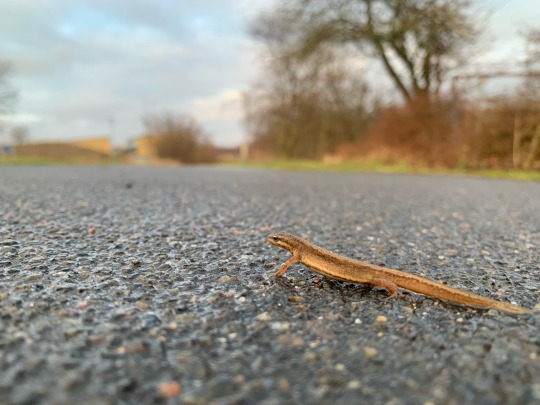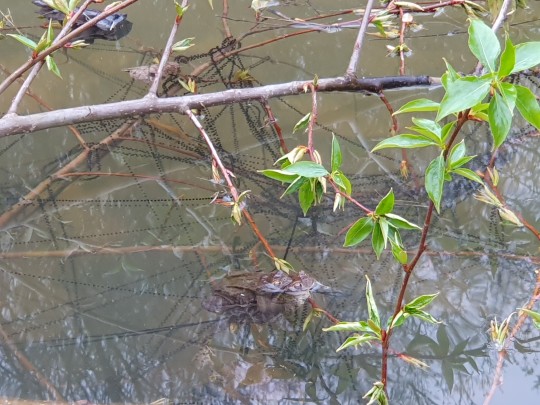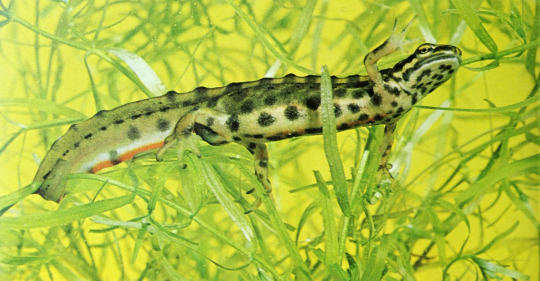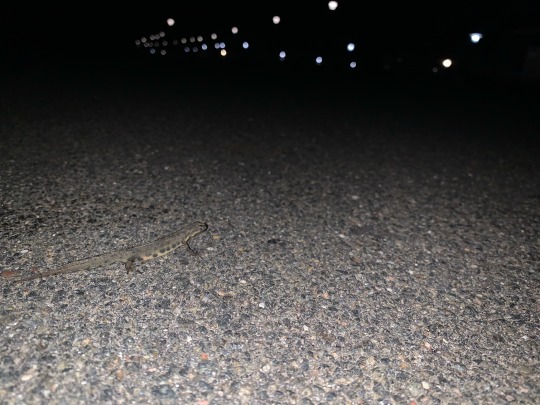#Lissotriton vulgaris
Text

Look at this friend I made on my way home the other day! What a glorious creature! So gracile and smooth! Truly a peak being. What a privilege it is to share this time in Earth’s history with creatures like this.
#field herping#Herpetology#nature#wildlife#animals#newt#salamander#Lissotriton#Lissotriton vulgaris#newt newt motherf***ers#friend shaped#this is a bad place for this friend to be#I see freshly dead newts on this path EVERY DAY#hundreds killed per year#so every time I find one I gently move it away#my habit of saying ‘hello friend’ to every animal has been adopted by my two-year-old#and it is magical#he literally says ‘helo fren!’
1K notes
·
View notes
Photo

26 notes
·
View notes
Text

0 notes
Text

Smooth Newts (Lissotriton vulgaris), males in breeding form, family Salamandridae, Sweden
photograph by Pontus Hjelm
302 notes
·
View notes
Text




I had some important decisions to make the past weeks, one of them is that I want to learn more about amphibians specifically because I love them so much and know so little.
As a token of that, please enjoy some toads (with so many eggs! So much spawn!) and newts! Bufo bufo and Lissotriton vulgaris, I believe. I found them in a vernal pool among some fossilized sea floor (See my other posts for more pictures of that)! There were so many amphibians there, I have not seen that many in one place in ages. It is in a nature reserve :)
04/2024, Germany
60 notes
·
View notes
Text

Smooth newt (Lissotriton vulgaris)
By: J. L. Mason
From: The Complete Encyclopedia of the Animal World
1980
#smooth newt#salamander#amphibian#1980#1980s#J. L. Mason#The Complete Encyclopedia of the Animal World (1980)
132 notes
·
View notes
Note
I'm really sorry if you already answered but I did look through the whole lexicon and used control+f. Do we have words for Lizards/Newts//Salamanders/Reptiles?
I wanted to see the Clanmew names for 2 OCs Lizardsong and Salamanderclaw. The second being a Skyclan Daylight Warrior!
The word for reptile is "Skeep"! It is a wingless, typically scaled animal without fish "wings". So, it actually includes amphibians as well. This is because there are very few reptiles in the UK; Clan cats don't see why an amphibian is not simply a water-reptile.
So to them, a lizard is a four-legged reptile with a tail. It includes all of the newts that they encounter on a regular basis, even though these are technically amphibians. What are you gonna do, teach the cats cladistics?
Lizard (Generic) = Ssassa
Adult newts and lizards, without breeding season adornments. Has 6 species.
Sail (of a fish or a breeding male newt) = Saoss
The dorsal fins on top of a fish or a breeding male newt.
Viviparous Lizard (Zootoca vivipara) = Sipssa
Eggs are much rarer in this part of the world than you might think. Like its name suggests, the viviparous lizard typically gives live birth, which is likened to the adder. This is the most common lizard in the area, encountered by all Clans.
Sand Lizard (Lacerta agilis) = Hwoossa
Named for being seen mostly in WindClan's sandy lowland heath, because this IS an animal that lays eggs. It needs sunny, sandy areas to be able to hatch a brood.
Smooth Newt (Lissotriton vulgaris) = Fyenssa
A contraction of "Flame's Lizard," for the quirk where these newts will often hide in piles of cold, wet wood, only to flee out when a fire is lit. The most common newt to encounter, feel free to translate as "salamander!"
Palmate Newt (Lissotriton helveticus) = Horrssa
The "shade newt," so named because this one generally prefers forested, green areas. Its tail is much fatter than the other newts.
Great Crested Newt (Triturus cristatus) = Gisis
What was once the Tribemew word for all lizards now only describes the great crested newt, the largest and most respected of the "lizard" classification. An accomplished hunter with an impressive sail during its breeding season, on both the back and the tail.
Some extra facts about newts and lizards in general...
Scientifically, all newts are salamanders, but not all salamanders are newts. You could translate any one of these words as "salamander."
Through their lives, newts will have terrestrial phases and aquatic phases.
Britain's cold climate and isolation as an island means there are very few reptiles in general; amphibian species outnumber them because it is very wet.
Slowworms are technically a lizard, but Clan cats believe they are a snake.
Clan cats also believe that snakes were not originally reptiles, but worms. There is a story about a cat who hunted them to extinction and then had to recreate them from memory, forgetting that worms don't have scales.
56 notes
·
View notes
Photo




The Smooth Newt with the Smooth Moves
Also known as the European newt, northern smooth newt, or common newt (Lissotriton vulgaris), the smooth newt is one of the most common species in Europe and western Asia. It is also the only newt species found in Ireland. There are currently three recognised subspecies distributed throughout this range, and four others have been reclassified as distinct species. The common newt is able to survive in a variety of habitats, including deciduous and coniferous forests, wetlands, meadows, parks, and gardens. Their only requirements are sufficient sunlight and water with sufficient vegetation.
Like most newts, the northern smooth newt spends the majority of its time foraging for food on land. Their diet is carnivorous, consisting of insects, worms, snails, slugs, and larvae. When available, L. vulgaris may also eat the eggs of its own species. In turn, many animals prey on the European newt, including waterbirds, snakes, frogs, and larger newts. To avoid these predators the smooth newt is active mainly at night, and will secrete a toxic mucus when threatened. While active, they are largely solitary but from October to March several individuals will hibernate together under logs or leaf litter burrows.
Almost as soon as the common newt emerges from hibernation, they begin migration to their breeding sites-- usually the ponds in which they spawned. Males undergo a dramatic transformation, growing large crests and becoming brightly colored. When a female enters the water, the male swims around her and sniffs her cloaca. He then vibrates his tail to fan his pheromones towards her. Finally, he will swim away and, if the female is interested, she will follow him. He then deposits a packet of sperm, or spermatophore, that the female picks up for fertilization. Rival males may try to lead the female towards their own spermatophores, and clutches of eggs often have multiple fathers.
Females deposit anywhere from 100 to 500 eggs, each of which is carefully wrapped in aquatic vegetation. Larvae hatch after only 20 days, and quickly begin developing. Unlike frogs and toads, newt larvae have external, feathery gills, and develop their front legs first. After about three months, the larvae absorb their gills and leave the water as newtlets or efts. However, when temperatures are particularly low and aquatic prey is abundant, some adults retain their gills and stay aquatic in a phenomenon known as paedomorphism. These adults are fully capable of sexual reproduction, and when moved to areas with a larger population will often metamorphose into terrestrial adults.
Adult smooth newts are rather small, reaching only 9–11 cm (3.5–4.3 in) and 0.3–5.2 g (0.011–0.183 oz). Males are slightly larger than females. The head and back are dark brown or olive, while the underside is much lighter. Both males and females have dark spots on their bellies, and males also sport a bright orange stripe. In the spring, the colors in males become more vivid and the spots grow larger. Males also develop a large yellow crest that runs from the head to the table, and is dotted with dark bands.
Conservation status: The IUCN has designated the European newt as Least Concern, as it is common over most of its range. Threats include habitat destruction and the introduction of invasive fish species.
If you like what I do, consider leaving a tip or buying me a ko-fi!
Photos
Philip Precey
Derek Middleton
Christoph Moning via iNaturalist
Kristýna Coufalová via iNaturalist
#common newt#smooth newt#Urodela#Salamandridae#newts#salamanders#amphibians#deciduous forests#deciduous forest amphibians#evergreen forests#evergreen forest amphibians#grassland birds#grassland amphibians#wetlands#wetland amphibians#urban fauna#urban amphibians#europe#asia#west asia#animal facts#biology#zoology
147 notes
·
View notes
Text




Little creatures I've studied and saved in February-March 2023.
Each year, they try and cross a street to reproduce in a pond and some get rolled over by cars. The association I was working with created a "wall" to stop them from crossing with buried buckets to trap them. We had to look in every bucket every morning and evening, with an additional night patrol in the neighborhood to catch those who managed to pass the wall, to free them near the pond. In French, this system is called a Crapaudrome (from "Crapaud" meaning toad and -drome indicating movement).
You have here a common toad (Bufo bufo), a green frog (Pelophylax sp.), an alpine newt (Ichtyosaura alpestris), and a smooth newt (Lissotriton vulgaris).
11 notes
·
View notes
Text

Found this little critter in our garden at midnight... I wasn't aware we had newts in our garden. Gotta make them a mossy stacked twig winter retreat.
Not sure what species it is. The animal was around 4cm and thus a juvenile. The belly was bright yellow without spots to speak of.
Probably the common Teichmolch - Lissotriton vulgaris.
As a kid I always wanted newts so I am super happy we have them in our garden, despite the lack of a pond.
17 notes
·
View notes
Text
[CM] Amphibians
Amphibians! These words were all very fun to come up with. Who doesn’t like listening to frog sounds? Below we have translations for four frogs, three salamanders, and one fellow with a name from base Clanmew.
Common toad (Bufo bufo) - Amam*
Small and common. Poisonous to eat, but some cats like to chase them anyway.
Spring peeper (Pseudacris crucifer) - Eep
Tiny chorus frog with light peeping calls that are a tell-tale sign of spring. This word is also an unintentional homonym with base Clanmew eep*, which means black rat!
Bullfrog (Lithobates catesbeianus) - Rroak
Large distinct frog with a loud, deep call. A common game among apprentices is ranging up-and-down riverbanks and looking for bullfrogs to startle into the water.
Green frog (Rana clamitans) - Ook
Second-largest frog on ClayClan territory. Green frogs are very territorial - some cats like to watch them wrestle!
Pickerel frog (Lithobates palustris) - Rroo
Heavily spotted frog. Stressed pickerel frogs produce a toxic secretion that makes them poisonous to eat; it may also irritate skin.
Wood frog (Lithobates sylvaticus) - Rrikrrik
Brown-and-black frog. Sometimes found frozen in the dead of winter - cats believe them to be dead during this time, but they actually thaw in the spring!
Spotted salamander (Ambystoma maculatum) - Sslip
Large salamander with distinct yellow spots. Bitter and poisonous, never hunted.
Dusky salamander (Desmognathus fuscus) - Mwip
Mottled and relatively nondescript salamander. Occasionally found foraging in wet shady spots.
Common newt (Lissotriton vulgaris) - Ssliks
Little spotted newt. Found on land most of the year, but move into ponds for the breeding season. Also known as efts; the acolyte Eftrunner’s Claymew name, Sslikspanpean, could also be translated as Newtrunner.
5 notes
·
View notes
Text

Every time I come home after dark I find newts both alive and smashed on a cycle/foot path near my home. It turns out they are coming to the path specifically to hunt for worms.
Before I moved here, I had no idea just how much of an ecological impact even a path with very low pedestrian density can have. How can foot traffic and the occasional bike kill as many as seven newts in a single day, on a 200 m stretch of path?
It’s frankly baffling and upsetting, especially because I know that every newt I move off the path will come back onto it. But, at least for now, all I can do is observe.
#I may actually conduct a formal study on this#we shall see#newt#conservation#Lissotriton#Lissotriton vulgaris#smooth newt
426 notes
·
View notes
Note
imagine having bog teeth in real life. your breath would be so stinky. imagine like going to eat a burger and like you spit out a smooth newt omg i just looked up smooth newt

Scientific Name: Lissotriton vulgaris
Also known as the common newt, the smooth newt is found throughout Europe. It is also the only newt species found in Ireland.
Smooth newts are often found in bogs, marshes, wetlands, and even woodland areas. During the breeding season, however, they typically head to ponds and ditches where there is standing water and weeds.
These amphibians are nocturnal and not normally seen during the day. At night, they come out of hiding to hunt for food.
true i would not want bog teeth irl. thank youf or the newt. new mascot of this blog

3 notes
·
View notes
Text

0 notes
Text

Smooth Newt (Lissotriton vulgaris), male in breeding form, family Salamandridae, Bavaria, Germany
photograph by Laura Bok
346 notes
·
View notes
Video
youtube
Smooth Newts on Springwatch (2022)
Ponds are a valuable habitat for a number of animals, in this segment we visit one that is inhabited by Smooth Newts (Lissotriton vulgaris). We learn about the courtship of newts, and how the male transfers his sperm packet to the female, before she lays her eggs.
via: British Herpetology
14 notes
·
View notes